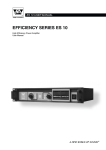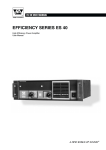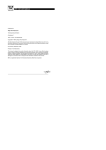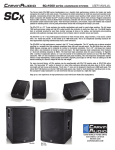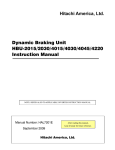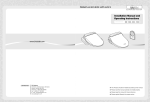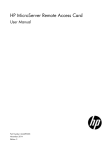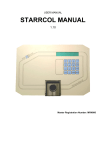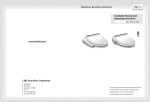Download SCREEN SERIES SSA 100
Transcript
R SSA 100 USER MANUAL stage accompany SCREEN SERIES SSA 100 High Efficiency Cinema Power Amplifier User Manual R SSA 100 USER MANUAL stage accompany Published by: New Stage Accompany B.V. Training & Documentation Anodeweg 4 1627 LJ Hoorn, The Netherlands Copyright © 2001 by New Stage Accompany B.V. All rights reserved. No part of this manual may be reproduced or transmitted in any form or by any means, electronically or mechanical, without written permission from New Stage Accompany B.V. , except for the inclusion of brief quotations in a review. First printing, May 2001 Printed in The Netherlands This manual is intended to provide information about the Stage Accompany SSA 200. Every effort has been made to make this manual complete and as accurate as possible. However no warranty of suitability, purpose, or fitness is implied. The information is provided on an “as-is” basis. New Stage Accompany B.V. shall have neither liability nor responsibility to any person or entity with respect to any loss or damages in connection with or arising from the information contained in this manual. New Stage Accompany B.V. reserves the right to alter specifications without prior notice. R SSA 100 USER MANUAL stage accompany Table of Contents Quick Introduction to the SSA 100 Introduction Connections Operation Recommendations Technical Specifications Warranty Overview SSA 100 USER MANUAL R stage accompany 1 Quick Introduction to the SSA 100. . . . . . . . . . . . . . . . . . . . . . . . . . . . . . . 1-1 2 Introduction . . . . . . . . . . . . . . . . . . . . . . . . . . . . . . . . . . . . . . . . . . . . . . . . . 2-1 3 Connection of the SSA 100 . . . . . . . . . . . . . . . . . . . . . . . . . . . . . . . . . . . . . 3-1 3.1 Mains Power Connection . . . . . . . . . . . . . . . . . . . . . . . . . . . . . . . . . . . 3-1 3.2 Booth Monitor Connection . . . . . . . . . . . . . . . . . . . . . . . . . . . . . . . . . . 3-4 3.3 Audio Connections . . . . . . . . . . . . . . . . . . . . . . . . . . . . . . . . . . . . . . . . 3-4 3.4 Loudspeaker Connections . . . . . . . . . . . . . . . . . . . . . . . . . . . . . . . . . . 3-5 Operation . . . . . . . . . . . . . . . . . . . . . . . . . . . . . . . . . . . . . . . . . . . . . . . . . . . 4-1 4.1 Input Attenuators . . . . . . . . . . . . . . . . . . . . . . . . . . . . . . . . . . . . . . . . . 4-1 4.2 Ground Lift Switch . . . . . . . . . . . . . . . . . . . . . . . . . . . . . . . . . . . . . . . . 4-2 4.3 Indicators . . . . . . . . . . . . . . . . . . . . . . . . . . . . . . . . . . . . . . . . . . . . . . . 4-2 5 Recommendations for Optimum Use. . . . . . . . . . . . . . . . . . . . . . . . . . . . . 5-1 6 Technical Specifications . . . . . . . . . . . . . . . . . . . . . . . . . . . . . . . . . . . . . . . 6-1 7 Warranty . . . . . . . . . . . . . . . . . . . . . . . . . . . . . . . . . . . . . . . . . . . . . . . . . . . . 7-1 8 Overview . . . . . . . . . . . . . . . . . . . . . . . . . . . . . . . . . . . . . . . . . . . . . . . . . . . . 8-1 4 TABLE OF CONTENTS Table Of Contents 1-1 R SSA 100 USER MANUAL stage accompany 1 Quick Introduction to the SSA 100 • Ensure that you have a reliable, well earthed power source. The required current for the SSA 100 can be found in the table in paragraph 3.1. • Connect the SSA 100 to your signal sources via the <INPUT> connectors. Or connect the SSA 100 to your booth monitor using the 15 pin D-type Data Port connector. • Connect your speaker system via the <OUTPUT> connectors. • Never make connections to the amplifier or to any preceding equipment with the amplifier switched on! • Select the desired gain by means of the <GAIN CONTROLS>. • Switch the SSA 100 on using the <POWER ON/OFF> switch. • Any earth hum that may be present may be solved with the <GROUND LIFT> switch. The SSA 100 is now ready for use. QUICK INTRODUCTION Thank you for choosing a Stage Accompany Power Amplifier. Making this choice has guaranteed you many years of troublefree amplification. If you have to start using the SSA 100 straight away and do not have time to read the complete manual, make sure that you at least read the following: 2-1 R SSA 100 USER MANUAL stage accompany 2 Introduction The Stage Accompany SSA 100 is a dual channel, high efficiency power amplifier and comprises the following components: • Balanced input stages. • Two high efficient amplifiers which deliver each 290 Wrms into 8 Ω, 425 Wrms into 4 Ω and 525 Wrms into 2 Ω or 340 W peak into 8 Ω, 535 W peak into 4 Ω, and 700 W peak into 2 Ω. • Advanced protection circuits. The SSA 100 is protected against the connection of speaker impedances less than 2 Ω or even short circuiting of the output. In these cases the output current is limited but the amplifier keeps working. The SSA 100 has a number of features, including: • High efficiency class G operation. • Variable speed DC fan. • DDC (Dynamic Damping Control). • EFN circuit (Extended Function Network) • Soft start to reduce power on inrush current. • Temperature, DC, HF and short circuit protection. Class G operation The power supply of the SSA 100 amplifier produces 2 different supply levels. Each channel actually consists of two power amplifiers. One produces the output signal, the other one selects the power supply voltage. This way, the SSA 100 uses the low level supply at low output power and the high level supply at high output power which reduces internal dissipation significantly. INTRODUCTION • D-type connector for easy connection to Cinema Booth Monitor. 2-2 R SSA 100 USER MANUAL stage accompany DC Fan The built in DC fan has a continuous variable speed. Its control circuit monitors the temperature of the output devices and the temperature of the power supply. The speed of the fan is calculated out of this information. This system ensures that the fan always runs at optimum speed and thus produces less noise. DDC EFN Through the internal EFN circuit, with plug-in modules, extra functions can be added to the amplifier, like cross-over, high- low- or band-pass filtering, equalisation and loudspeaker protection. Special filter and protection boards are available for all Stage Accompany loudspeaker systems. The installation of an EFN module needs to be done by an authorized Stage Accompany service center. Soft Start The soft start circuit is active when the SSA 100 is switched on. The mains inrush current, which normally is in excess of 100 A is limited to a safe value. However, take care not to switch on too many amplifiers at the same time, or you risk that the main fuses of your distribution may trip. Temperature, DC, HF and Short Circuit Protection The amplifier and the loudspeakers are protected against all possible damages. INTRODUCTION DDC (Dynamic Damping Control) is a special way of measuring the cone movement of a loudspeaker. The voltage induced in the voice coil is sensed and fed back to the amplifier’s feedback circuit. Hence, a virtually infinite damping is achieved, which results in an exceptionally tight sound reproduction and less distortion. 3-1 R SSA 100 USER MANUAL stage accompany 3 Connections Only three connections need to be made: mains power, audio input signals or booth monitor connection, and loudspeaker leads. Do not make any connections to the amplifier or to any preceding equipment with the amplifier switched on! 3.1 Mains Power Connection SSA 100 Mains Supply SSA 100 SSA 100 SSA 100 OK SSA 100 SSA 100 Figure 3-1 SSA 100 connections to the mains supply. Mains Supply CONNECTIONS The SSA 100 is internally selectable for 110-120/220-240V 50/60Hz mains voltage. The exact voltage is stated at the rear of the amplifier. Switching between mains voltages has to be done by an authorised Stage Accompany service centre. Connecting to the wrong voltage is dangerous and may damage the amplifier. Always ensure that you use a correctly grounded power supply. If more than one SSA 100 is to be used, it is advisable to connect each one separately to the nearest mains supply in stead of connecting several SSA 100s using an adapter block (see figure 3-1). 3-2 SSA 100 USER MANUAL R stage accompany This will prevent unnecessary power loss in the mains cables. If circumstances do not allow this, it is advisable to connect the adapter block directly to the power supply using a short cable and then connect the individual SSA 100s to it using longer leads. Although this method is not ideal, it does limit power loss as much as possible. Ultimately, it is possible to place the adapter block near the SSA 100s, but if a great deal of power is required from the unit, the final current provided is far from optimum: loss of current leads to unrecoverable loss of output power and therefore sound pressure. Warning : Current Table Below, the current consumption of the SSA 100 is tabulated for two selectable mains voltages. The power consumption shown applies to 1/8 of maximum output power pink noise in 2 Ω, which is representative for typical music program with occasional clipping. If your speaker system has an impedance of 4 or 8 Ω you may multiply the currents by 0.5 or 0.25. Mains Voltage (V) No. of SSA 100s 110-120 220-240 Current Consumption (A) Table 3-1 1 6 3 2 12 6 3 18 9 4 24 12 5 30 15 6 36 18 7 42 21 8 48 24 9 54 27 Current consumption as a function of the mains voltage at 1/8 of maximum output power with pink noise in 2 Ω. The mains voltage may NOT deviate more than -20 % to +10 % of the nominal value. The proportional mains voltage cable loss may not exceed 10 %. The following formula may be used to calculate the maximum mains cable length in meters for 220-240 V models: CONNECTIONS Always disconnect the SSA 100 from the power supply before operating on the fuse holders! Replace a blown fuse only with a new one of the same type and value! 3-3 R SSA 100 USER MANUAL stage accompany Maximum Length (ML) = G * 120 N The two input variables are: N - number of SSA 100s supplied through the cable G - cable gauge in square millimeters Maximum Length (ML) = CONNECTIONS For 110-120 V models the following formula applies: G * 30 N This means that the cable length is proportional to the cable gauge, while it is inversely proportional to the number of SSA 100s supplied through the cable. On this and the next page, per mains voltage a table is shown with the maximum mains cable length in meters, given the cable gauge in square millimeters and the number of SSA 100s supplied through the cable. Cable Gauge (mm2) 110-120 V No. of SSA 100s Table 3-2 1.5 2.5 4.0 6.0 10.0 16.0 1 46 75 120 180 300 480 2 23 38 60 90 150 240 3 15 25 40 60 100 160 4 11 19 30 45 75 120 5 9 15 24 36 60 96 6 8 13 20 30 50 80 7 6 11 17 26 43 69 8 6 9 15 23 38 60 9 5 8 13 20 33 53 10 5 8 12 18 30 48 Maximum cable length as a function of the cable gauge and the number of SSA 100s supplied through the cable. 3-4 R SSA 100 USER MANUAL stage accompany Cable Gauge (mm2) 220-240 V Table 3-3 3.2 2.5 4.0 6.0 10.0 16.0 1 180 300 480 720 1200 1920 2 90 150 240 360 600 960 3 60 100 160 240 400 640 4 23 75 120 180 300 480 5 36 60 96 144 240 384 6 30 56 80 120 200 320 7 26 43 69 103 171 274 8 23 38 60 90 150 240 9 20 33 53 80 133 213 10 18 30 48 72 120 192 Maximum cable length as a function of the cable gauge and the number of SSA 100s supplied through the cable. Booth Monitor Connection The SSA 100 can easily be connected to a cinema booth monitor through the HD15 Data Port connector. All signals for monitoring the amplifier’s inputs and outputs as well as input signals and various control signals are present on this connector. Only two more connections have to be made to the amplifier: power and loudspeaker cables. 3.3 Audio Connections The XLR input connectors of the SSA 100 are wired as follows: Pin 1 = ground Pin 2 = normal phase (signal+ or “hot”) Pin 3 = inverted phase (signal- or “cold”) + 2 1 3 NEUTRIK + Always use high quality XLR connectors and shielded signal cables. The input stages are electronically balanced. To make optimum use of the balanced input stages even in unbalanced situations, use balanced signal cables and connect pin 3 to pin 1 at the output of the preceding equipment. If this is not possible, connect pin 3 to pin 1 at the input of the SSA 100. CONNECTIONS No. of SSA 100s 1.5 3-5 R SSA 100 USER MANUAL stage accompany 3.4 Loudspeaker Connections Due to the DDC feature, the SSA 100 has 4 output terminals per channel instead of 2. The loudspeaker output connector is wired as follows: + Pin 1+ = “hot” or Signal+ Pin 1- = “cold” or Signal- 1+ 2- 1- NEUTRIK + 2+ Pin 2- = “DDC cold” or DDC- For optimum performance, the amplifier to loudspeaker connections should be made as shown in figure 3-2. SPEAKON NL4FC 2+ + 2- 11+ Figure 3-2 SSA 100 4-terminal loudspeaker connection. The signal+ and DDC+ (Dynamic Damping Control) terminals are linked together at the loudspeaker + terminal. The signal- and DDC- terminals are linked at the loudspeaker - terminal. A maximum damping is obtained with these connections. If your speaker system is not prepared for a four terminal connection, link the DDC and the signal leads at the input of the enclosure (see figure 3-3). SPEAKON NL4FC 2+ + 2- 11+ Figure 3-3 SSA 100 2-terminal loudspeaker connection CONNECTIONS Pin 2+ = “DDC hot” or DDC+ 3-6 R SSA 100 USER MANUAL stage accompany If you don’t want to use the DDC feature at all, the DDC and the signal leads should be linked at the amplifier output in the speakon connector (see figure 3-4). The DDC terminals can also be left unconnected but then the performance will be less. SPEAKON NL4FC 2+ + 2- 11+ SSA 100 loudspeaker connection without DDC. Warning ! Never short-circuit the DDC terminals, and never connect the signal+ output terminal to the DDC- terminal or vice versa (see figure 3-5). Since you are disabling the amplifier’s feedback network, signal gain will be almost infinite. The smallest input signal will result in full power output with the possibility of square waves damaging your loudspeakers! Therefore, check your cables regularly. We also advice you to use special Stage Accompany 4-wire loudspeaker cable: 2 x 3.0 mm2 and 2 x 0.75 mm2 . SPEAKON NL4FC 2+ + 2- 11+ Figure 3-5 Dangerous SSA 100 output connection. SPEAKON NL4FC 2+ + 2- 11+ Figure 3-6 Dangerous SSA 100 output connection CONNECTIONS Figure 3-4 3-7 SSA 100 USER MANUAL R stage accompany When more speakers are going to be connected to one amplifier, split the output and DDC leads as soon as possible behind the output terminals of the SSA 100 (see figure 3-7 on this and figure 3-8 on the next page). SPEAKON NL4FC 2+ + 2- 1+ Figure 3-7 Try to avoid this way of connecting several enclosures to the SSA 100. CONNECTIONS 1- 3-8 SSA 100 USER MANUAL R stage accompany SPEAKON NL4FC 2+ + 2- 11+ OK CONNECTIONS Figure 3-8 Correct way of connecting several enclosures to the SSA 100 The amplifier can cope with any load of 2 Ω or higher. This means that you may connect a maximum of two 4 Ω, four 8 Ω, or eight 16 Ω loudspeakers per channel in parallel. Linking the loudspeakers from one enclosure to another has two major disadvantages: 1.The loudspeaker cable from the amplifier to the first enclosure conducts the current for all enclosures, which means extra losses. 2.The DDC only works for the first enclosure. Splitting the leads at the amplifier output terminals solves these problems (see figure 3-8). The DDC system corrects the performance loss due to connectors, loudspeaker cables and so on. However, it cannot prevent loss of power. So only use cables of minimal 2 x 1.5 mm2 or more for the loudspeaker leads and 2 x 0.75 mm2 for the DDC leads. 3-9 R SSA 100 USER MANUAL stage accompany An indication of the proportional cable power loss (percentage of the amplifier’s total output power) can be calculated using the following formula: 100 Proportional Power Loss = 1+ 29.4 * G * R L where the variables represent: - cable length in meters G - cable gauge in square millimeters R - DC resistance of the loudspeaker(s) in ohms This formula is based on the DC resistance in stead of the complex impedance of the loudspeaker(s). However, the approximation can be used to get a good impression of the loudspeaker cable power loss. Per loudspeaker impedance a table is shown in tables 3-9 to 3-12 with the proportional power loss, given the loudspeaker cable gauge in square millimeters and the cable length in meters. 16 Ω Cable Length (m) Table 3-4 Cable Gauge (mm2) 1.5 2.5 3.0 4.0 6.0 10.0 16.0 10 1.4 0.8 0.7 0.5 0.4 0.2 0.1 20 2.8 1.7 1.4 1.1 0.7 0.4 0.3 30 4.1 2.5 2.1 1.6 1.1 0.6 0.4 40 5.4 3.3 2.8 2.1 1.4 0.8 0.5 50 6.6 4.1 3.4 2.6 1.7 1.1 0.7 100 12.4 7.8 6.6 5.0 3.4 2.1 1.3 Proportional power loss as a function of loudspeaker cable gauge and cable length (%). CONNECTIONS L 3-10 R SSA 100 USER MANUAL stage accompany 8Ω Cable Length (m) 1.5 2.5 3.0 4.0 6.0 10.0 16.0 10 2.8 1.7 1.4 1.1 0.7 0.4 0.3 20 5.4 3.3 2.8 2.1 1.4 0.8 0.5 30 7.8 4.9 4.1 3.1 2.1 1.3 0.8 40 10.2 6.4 5.4 4.1 2.8 1.7 1.1 50 12.4 7.8 6.6 5.0 3.4 2.1 1.3 100 22.1 14.5 12.4 9.6 6.6 4.1 2.6 Proportional power loss as a function of loudspeaker cable gauge and cable length (%). 4Ω Cable Length (m) Table 3-6 1.5 2.5 3.0 4.0 6.0 10.0 16.0 10 5.4 3.3 2.8 2.1 1.4 0.8 0.5 20 10.2 6.4 5.4 4.1 2.8 1.7 1.1 30 14.5 9.3 7.8 6.0 4.1 2.5 1.6 40 18.5 12.0 10.2 7.8 5.4 3.3 2.1 50 22.1 14.5 12.4 9.6 6.6 4.1 2.6 100 36.2 25.4 22.1 17.5 12.4 7.8 5.0 Proportional power loss as a function of loudspeaker cable gauge and cable length (%). 2Ω Cable Length (m) Table 3-7 Cable Gauge (mm2) Cable Gauge (mm2) 1.5 2.5 3.0 4.0 6.0 10.0 16.0 10 10.2 6.4 5.4 4.1 2.8 1.7 1.1 20 18.5 12.0 10.2 7.8 5.4 3.3 2.1 30 25.4 16.4 14.5 11.3 7.8 4.9 3.1 40 31.2 21.4 18.5 14.5 10.2 6.4 4.1 50 36.2 25.4 22.1 17.5 12.4 7.8 5.0 100 53.1 40.5 36.2 29.8 22.1 14.5 9.6 Proportional power loss as a function of loudspeaker cable gauge and cable length (%). CONNECTIONS Table 3-5 Cable Gauge (mm2) 4-1 R SSA 100 USER MANUAL stage accompany 4 Operation After connection to the correct mains voltage, the SSA 100 can be switched on using the <POWER ON/OFF> switch. The various functions of the system will now be described one after one. 4.1 Input Gain Controls The input gain controls consist of two conductive plastic potentiometers situated on the rear side of the amplifier, which are calibrated in dB. The controls are used to mute the input signal or to adjust the sensitivity of the SSA 100 to other amplifiers. The relative sensitivity to other Stage Accompany amplifiers is: 0 dB +5 dB +2 dB -1 dB +5 dB +2 dB +2 dB Attenuation in the complete counter clockwise position (-∞) is > 90 dB. 4.2 Ground Lift Switch If hum is audible after switching on the SSA 100, the cause may be incorrect earthing of your sound system. The <GROUND LIFT> switch can be used to “lift” the connection between the system earth and the mains earth. This action alone is often sufficient to eliminate the undesired noise caused by a “bad grounding system”, or “ground loops”. 4.3 Indicators Each channel of the amplifier is equipped with the following indicators: • POWER: these LEDs will light when the amplifier is switched on. • SIGNAL: these LEDs will light when an input level of more than 40 dB under the level that would cause maximum power (+5 dBu) is detected at the input connectors. The signal present LEDs work independently of the settings of the input gain controls. OPERATION SSA 200: ES 10: ES 20: ES 40: SA 800: SA 1600 PPA 1200: 4-2 R SSA 100 USER MANUAL stage accompany • CLIP: this LEDs will light when the output levels of the amplifier have reached theirlimits. The indication is correct for every connected impedance. When the clip LEDs flash frequently, distortion is to be expected. • PROTECT: when these LEDs light, one of the following errors has occurred. 1: Thermal overload; the output devices of this channel have reached a temperature of 90 degrees centigrade and the input of that channel is muted. Both channels work independently, so themal overload of one channel does not affect the other channel. In case of a continued overload, it is possible that the power supply runs hot. Also in that case, the amplifier’s inputs are muted. When the internal temperatures have dropped 5 degrees the amplifier is unmuted. 3: HF on input; this indicates that high frequencies are detected on the inputs. In this case check you input cables. It is also possible that the signal from any preceding apparatus contains oscillations. When the <PROTECT> LEDs light during normal use and the amplifier is not hot, check the following things: Disconnect the input signal connectors. When the LED(s) switch(es) off, High frequencies where probably present on the inputs. When this does not solve the problem you may try disconnecting the speaker system. When the LED(s) switch(es) off DDC was probably not properly connected. When neither of this solves the problem, The amplifier is probably damaged and should be repaired by an authorised Stage Accompany service centre. OPERATION 2: DC on output; this indicates that a sufficient amount of DC or subsonic energy is detected at the output of the amplifier and that the output connector is decoupled from the amplifier. This also occurs when the amplifier is switched on and the electronic circuits need time to stabilise. Approximately two seconds after you turn on the SSA 100 these LEDs should turn off. 5-1 R SSA 100 USER MANUAL stage accompany 5 Recommendations for Optimum Use • Ensure that the quality of the mains supply is good enough and that it can supply the required peak currents. In addition, good earthing is necessary to prevent noise, hum and safety problems. If hum does occur, it may be solved by using the ground lift switch on the back of the amplifier. • Be sure that the SSA 100 is built into a space with sufficient circulation of fresh air. A temperature that is constantly too high leads to switching on and off of the thermal protection and considerably reducing the lifetime of the amplifier. • When built into a flightcase, ensure yourself that there are sufficient possibilities for the • Do not make connections to the amplifier or to any preceding equipment with the amplifier switched on • A faulty fuse must ALWAYS be replaced by a new one of the same type and value! A different fuse can cause permanent damage to the amplifier. All internal fuses are of an automatic type, so they do not need to be replaced. Always disconnect the SSA 100 from the power supply before operating on the fuse holder! When a replaced fuse immediately blows again, the amplifier is defect and should be repaired by an authorised Stage Accompany service centre. Do not try to replace the fuse again because you may risk further damage to the amplifier. • Repairs to the SSA 100 should only be carried out by an authorised Stage Accompany service centre. Never dismantle the SSA 100 yourself, you may risk damaging vital components: moreover, the guarantee becomes irrevocably invalidated. • Read this manual carefully. Try out the various functions described in this manual. In this way you will soon become familiar with the many possibilities that the SSA 100 offers. It is just as important that your colleagues who will use the SSA 100 also read the manual! With a good knowledge of the working of the SSA 100, it is possible to fully utilize its superior sound quality in every situation. GOOD LUCK! RECOMMENDATIONS heated air to leave the flightcase. When more SSA 100s are built into one flightcase, install an extra fan in the case. Air flow of the SSA 100 goes from front to back. 6-1 R SSA 100 USER MANUAL stage accompany 6 Technical Specifications 1.0 Vrms (+2.5 dBu) (full continuous power into 4 Ω) Maximum Input Level: +20 dBu Input Impedance: 20 kΩ balanced Common Mode Rejection Ratio (CMRR): > 55 dB @ 1 kHz Frequency Range: 15 Hz - 20 kHz, -0.3 dB < 10 Hz - 70 kHz, -3 dB Gain: 32 dB (40x) Channel Separation: 75 dB @ 1 kHz, 50 W into 8 Ω 55 dB @ 20 kHz, 50 W into 8 Ω Total Harmonic Distortion (THD): < 0.3 % @ 20 Hz - 20 kHz, more than 2 Ω load at all powers, 1 dB below clipping. < 0.01 % @ 1 kHz, 50 W into 8 Ω < 0.1 % @ 20 kHz, 50 W into 8 Ω Intermodulation Distortion (SMPTE IMD): < 0.07 % @ 200 Hz - 10 kHz, < 0.2 % @ 10 kHz - 20 kHz f1 = 70 Hz, 4:1, @ 50 W into 8 Ω Signal to Noise Ratio: > 112 dB A-weighted Slew Rate: > 40 V/µs @ 8 Ω Damping (with DDC): > 10.000 @ 1 kHz, 10 V, 8 Ω Output power @ 1 % THD: Continuous Power Delivered: 2 x 290 W RMS into 8 Ω 2 x 425 W RMS into 4 Ω 2 x 525 W RMS into 2 Ω Peak Power Delivered: 2 x 340 W into 8 Ω 2 x 535 W into 4 Ω 2 x 700 W into 2 Ω Mains Supply Voltage: internally switchable 110-120/220-240 VAC SPECIFICATIONS Input sensitivity: 6-2 R SSA 100 USER MANUAL stage accompany Power consumption typical Idle: 1/8 Power, pink noise @ 2 Ω: 50 VA 700 VA Weight: 17.7 kg / 39 lb Housing: 19 in rack mount, 2 HU high, 410 mm (16.1 in) deep behind the mounting surface (without connectors) Dimensions (h x w x d): 88 x 482 x 415 mm (without connectors and rack handles) (5.25 x 19.0 x 16.3 in) SPECIFICATIONS 7-1 R SSA 100 USER MANUAL stage accompany 7 Warranty New Stage Accompany B.V. warrants to the initial purchaser of each new Stage Accompany product, from the date of purchase by the original purchaser until the end of the warranty period, that the product is free of defects in materials or workmanship. The warranty period on all Stage Accompany products is five years from the date of the first consumer purchase, with the exception of: • all electrical products: three years from the date of the first consumer purchase; • cone assemblies in the loudspeaker and diaphragms of the Ribbon Compact Drivers: one year from the date of the first consumer purchase; • movable parts, such as castors, locks, handles, hinges, fans etc. one year from the date of the first consumer purchase; • computers and associated peripherals: six months from the date of the first consumer purchase. To validate warranty, the purchaser must always keep the original receipt of purchase to establish the date of purchase. • of defects caused by influence from the outside, accident, misuse, neglect or influence of water; • the serial number on the product has been defaced, altered or removed; • of damage due to shipment; • of damage resulting from neglecting instructions listed in the user manual; • of damage caused by incorrect, abnormal handling or abuse during delivery; • the unit has been repaired (or shows signs of repair) by someone not authorised by New Stage Accompany B.V.; • the original receipt of purchase cannot be presented whenever warranty service is required; • the cause of damage is unknown. WARRANTY Appeal on warranty will be voided in case: 7-2 R SSA 100 USER MANUAL stage accompany Shipment of the product to an authorised Stage Accompany service centre is at the risk and responsibility of the customer. New Stage Accompany B.V. will pay for all labour and material expenses for all repairs covered by the warranty. New Stage Accompany B.V. will not pay for the costs of shipment to the service centre or factory. However, New Stage Accompany B.V. will pay for the costs of return shipment to the customer if repairs are covered by warranty. Caution: Warranty work can only be performed at authorised Stage Accompany service centres or at the Stage Accompany factory. Every repair or attempted repair by a non-authorised party will void the warranty. New Stage Accompany B.V. reserves the right to alter specifications without prior notice. WARRANTY 8-1 R SSA 100 USER MANUAL stage accompany 8 Overview OVERVIEW

























